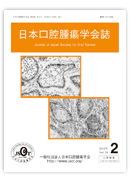All issues

Volume 24 (2012)
- Issue 4 Pages 129-
- Issue 3 Pages 63-
- Issue 2 Pages 35-
- Issue 1 Pages 1-
Volume 24, Issue 2
Displaying 1-6 of 6 articles from this issue
- |<
- <
- 1
- >
- >|
The 30th Annual Meeting of Japan Society for Oral Tumors
Workshop 2: The 1st training session “Kickoff of a resident manual in clinical oral oncology”
-
Ken OMURA2012Volume 24Issue 2 Pages 35-37
Published: June 15, 2012
Released on J-STAGE: August 01, 2012
JOURNAL FREE ACCESSDownload PDF (442K) -
KIRITA Tadaaki2012Volume 24Issue 2 Pages 38-40
Published: June 15, 2012
Released on J-STAGE: August 01, 2012
JOURNAL FREE ACCESSDownload PDF (222K) -
Seiji NAKAMURA2012Volume 24Issue 2 Pages 41
Published: June 15, 2012
Released on J-STAGE: August 01, 2012
JOURNAL FREE ACCESSDownload PDF (156K)
Clinical Reports
-
Shinsuke Tanaka, Noboru Akazawa, Hirokazu Yutori2012Volume 24Issue 2 Pages 43-48
Published: June 15, 2012
Released on J-STAGE: August 01, 2012
JOURNAL FREE ACCESSMany patients with head and neck cancers have double cancers in the upper gastrointestinal tract area. This study investigated 133 oral cancer patients who underwent upper gastrointestinal fiberscopy at the Department of Oral and Maxillofacial Surgery, Hyogo Cancer Center between January 2003 and December 2008. Double cancers were detected in the upper gastrointestinal tract area in 16 cases (12.0%). All of those patients were male, 12 had esophageal cancer and 4 had stomach cancer. Nine of 67 (13.4%) had a tumor on the tongue, 2 of 19 (10.5%) on the lower alveolus and gingiva, 3 of 18 (16.7%) on the floor of the mouth, 1 of 12 cases (8.3%) on the buccal mucosa, and 1 of 2 cases (50.0%) on the hard palate. Two of 38 cases were stage I, 8 of 32 cases (25%) were stage II, 2 of 19 cases (10.5%) were stage III, and 4 of 44 cases (9.1%) were stage IV. Twelve of 68 patients had a history of drinking and smoking, 4 of 14 patients had only a history of smoking, and 12 patients had only a history of drinking. There were 39 patients with no history of smoking or drinking and none of these patients had double cancers in the upper gastrointestinal tract area. Carcinoma in situ was detected early in 4 patients with esophageal cancer.View full abstractDownload PDF (392K)
Clinical Reports
-
A case of massive calcifying cystic odontogenic tumor occupying the maxillary sinus and nasal cavityMasanori Kudoh, Ken Omura, Hiroyuki Harada, Norihiko Okada2012Volume 24Issue 2 Pages 49-54
Published: June 15, 2012
Released on J-STAGE: August 01, 2012
JOURNAL FREE ACCESSCalcifying odontogenic cysts were first reported by Gorlin et al. in 1962, and were reclassified as calcifying cystic odontogenic tumors by the World Health Organization classification in 2005.
We report a case of a massive calcifying cystic odontogenic tumor arising in the maxilla and occupying the maxillary sinus and nasal cavity.
In February 2008, a 24-year-old male patient was referred to our department for a painless large mass in the right maxillary region. Panoramic X-ray showed a unilocular cystic lesion in the right maxilla containing a calcified mass in the lesion associated with root resorption of adjacent teeth. Computed tomography showed that the cystic lesion including calcified structures measured 5.2×4.7×3.7 cm. A biopsy specimen of the lesion revealed calcifying cystic odontogenic tumor. In April 2008, he underwent tumor extirpation combined with Caldwell-Luc operation. No recurrence was noted 3 years after the operation.View full abstractDownload PDF (1337K) -
Eiji Mitate, Kazunari Oobu, Daigo Yoshiga, Shintaro Kawano, Toshiyuki ...2012Volume 24Issue 2 Pages 55-61
Published: June 15, 2012
Released on J-STAGE: August 01, 2012
JOURNAL FREE ACCESSAdenosquamous carcinoma (ASC) is a rare malignant tumor in the oral and maxillofacial region. We report a case of ASC that arose in the mandibular gingiva. A 74-year-old man visited our hospital with the complaint of pain of the left submandibular gingiva and eating disorder in early January 2009. On the initial examination, there was an elastic soft, dark violet, and hemorrhagic mass of 55×25 mm in diameter in the left mandibular gingiva. He had hypoesthesia in his left mentum. The mass reached the mandibular canal on CT examinations, and two submandibular lymph nodes were suspected of metastasis on ultrasound examinations. A biopsy specimen showed components of squamous cell carcinoma and mucin-producing adenocarcinoma with positive reaction to diastase-digested periodic acid Schiff stain. We thus diagnosed this as ASC (T4N2bM0). As his condition of interstitial pneumonia was severe and he did not wish to receive surgical operation, he underwent radical chemoradiation therapy (oral administration of UFT and external radiation). After the therapy, some metastatic nodules were newly seen in areas of the lung, skin of the abdomen, and axillary skin. At the end of April, he died of breathing difficulties.View full abstractDownload PDF (1182K)
- |<
- <
- 1
- >
- >|